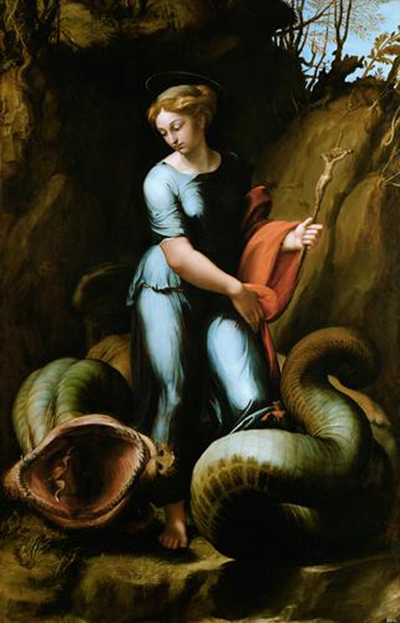Saint Margaret and the Dragon is an around 1518 painting of Saint Margaret by the famous Renaissance painter Raphael, which is now stored in the Kunsthistorisches Museum located in Vienna.
The depiction demonstrates the saint right now before she is gulped alive by the mythical dragon. She is demonstrated unafraid, holding the cross that will spare her once she is gulped. Another rendition demonstrating her holding a palm branch is stored in the collection of the Louvre. This composition was archived in David Teniers the Younger's list Theatrum Pictorium of the craftsmanship accumulation of Archduke Leopold Wilhelm in the year 1659 and also in 1673, however, the drawing had just appreciated reputation in Teniers' depictions of the Archduke's speciality gathering.
The mythical dragon's face is a vast topsy-turvy barbarity, one of the best detestations ever of the reptilian pyramid, with the red, cognizant eyes and humanoid nose. And after that mouth; pink and huge and unmistakably sufficiently massive to have gulped down this lady. The saint stands victorious - Raphael constructed her posture in light of a model of Victory - gently holding a triumphal palm and carefully venturing on the brute's wing with her exposed foot. Raphael makes her excellent, intensely female, her signals those of effortlessness instead of misery. Her body's shapes are erotically visible under her brilliant blue and red robes, and her bright hair falls over her chest.
Light fills the dim dump, concentrated on her, and she turns into a brilliant womanly signal in the evil spirit pervaded murkiness. Raphael's work of art is a dream of light crushing frightfulness, excellence and reason stifling beasts. This painting is one of an extraordinary gathering of Raphael's works in the Louvre that affected present-day craftsmanship. "Da Vinci guarantees paradise," said Picasso, "yet, Raphael, he offers it to us."
Saint Margaret is known to have lived in the fourth century in Antioch. Her dad disliked her Christian confidence, and one of her suitors requested that she repudiate Christianity in return for his turn in marriage. How did Margaret manage these two DBs? She implored and was tormented by being sustained to a mythical dragon. You wagered that specialists had an incredible time telling Margaret's story. Rather than delineating her being gulped or bitten to pieces, specialists regularly demonstrate Margaret was erupting from the side of the winged serpent. Legend has it that she supplicated inside the mythical dragon, crossed herself, and afterwards burst out of its side.
The variant by Raphael is one of the best. Simply take a gander at that evil looking mythical serpent! Such a work of art isn't just profoundly creative however holds the quiet restriction and clear shades of a High Renaissance painting. Raphael's artistic creation usually makes us feel better. Raphael's Vatican paintings have the opportunity and loftiness of the basic sketches he had seen by Leonardo and Michelangelo, however with a Florentine feeling of concordance. In the meantime, there is dramatization - Disputa makes philosophical contention energizing, St Margaret is a standout amongst the colours pictures in western craftsmanship.




